Seven meanings of the Cross (Michael Bressem, Ph.D.)
13 Απριλίου 2017
The symbol of the cross is ubiquitous in society. It is printed on bumper stickers and tattooed on forearms; it is spray painted on concrete walls and stitched onto denim jackets; it adorns the necks of gangsta rappers as well as scantily clad models. Is the cross merely a fashion statement, a cultural icon, a religious trademark, or is it something more?
 The cross is the third most celebrated subject in the Orthodox Church calender—the first two being the life of our Lord and the life of the Theotokos. The cross is commemorated on the feast day of the Exaltation of the Holy Cross (14 September), on the feast day of the Veneration of the Holy Cross (the third Sunday in Lent), and in the Thursday evening into Great Friday services during Holy Week. The cross receives so much attention because it is crucial for your understanding of the Christian faith. The word “crucial”—meaning decisive, critical, essential—comes from the Latin crux, from which we derive our English word “cross.” In other words, the most important event in history is what happened on the cross where Jesus Christ was executed. That act is at the root of salvation and is the basis for Christian theology. “Take therefore first, as an indestructible foundation, the cross, and build upon it the other articles of the faith” (St. Cyril of Jerusalem).
The cross is the third most celebrated subject in the Orthodox Church calender—the first two being the life of our Lord and the life of the Theotokos. The cross is commemorated on the feast day of the Exaltation of the Holy Cross (14 September), on the feast day of the Veneration of the Holy Cross (the third Sunday in Lent), and in the Thursday evening into Great Friday services during Holy Week. The cross receives so much attention because it is crucial for your understanding of the Christian faith. The word “crucial”—meaning decisive, critical, essential—comes from the Latin crux, from which we derive our English word “cross.” In other words, the most important event in history is what happened on the cross where Jesus Christ was executed. That act is at the root of salvation and is the basis for Christian theology. “Take therefore first, as an indestructible foundation, the cross, and build upon it the other articles of the faith” (St. Cyril of Jerusalem).
Reconciliation
There are many events in the Old Testament that foreshadow the cross: the blood of a lamb placed on lintels and doorposts during Passover (Exodus 12:23); Moses lifting his staff and parting the Red Sea (Exodus14:16); Moses’ outstretched arms in prayer for victory over Israel’s enemies (Exodus 17:8-15); and Israel being saved from poisoning by looking at a bronze serpent on a pole (Numbers 21:6-9). There are also prophetic allusions to the cross: the curse of being hung on a tree (Deuteronomy 21:23); the predicted passion of the Messiah (Psalm 22); the saving mark on the forehead (Exekiel 9:3-6, LXX; cf. Revelations 7:2-4; 22:4); and the blood that drips from wood (2 Esdras 5:5). These references attest that the cross was always part of God’s plan for salvation.
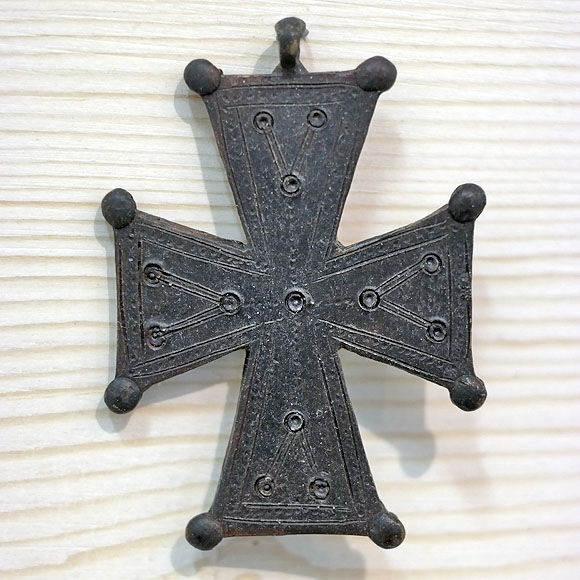
Cross by Romanian artist Ovidiu Simionescu
God reconciles His people by delivering us from the consequences of sin, and the means God uses to rescue us is the cross. Isaiah stated that the Messiah, “poured out his life unto death and was numbered with the transgressors. For he bore the sin of many, and made intercession for the transgressors” (Isaiah 53:12). The Apostle Paul confirmed this prophecy when he wrote, “For God was pleased to have all his fullness dwell in [Christ], and through him to reconcile to himself all things, whether things on earth or things in heaven, by making peace through his blood, shed on the cross” (Colossians 1:19-20; see also 2:13-15). Therefore the cross represents God’s victory over sin:
“For the cross destroyed the enmity of God towards man, brought about reconciliation, made the earth heaven, associated men with angels, pulled down the citadel of death, unstrung the force of the devil, extinguished the power of sin, delivered the world from error, brought back the truth, expelled the demons, destroyed temples, implanted virtue, [and] rounded the churches” (St. John Chrysostom).
Sacrificial Service
Christ stated on more than one occasion, “anyone who does not take his cross and follow me is not worthy of me. Whoever finds his life will lose it, and whoever loses his life for my sake will find it” (Matthew 10:38-39; also 16:24-25; Mark 8:34-35; Luke 9:23-24; 14:27). The cross represents your duty to follow in Christ’s footsteps. There are three aspects to this: first, you must mortify your fleshly desires in obedience to God. St. Symeon the New Theologian wrote:
“In times past, when heresies prevailed, many chose death through martyrdom and various tortures. Now, when we through the grace of Christ live in a time of profound and perfect peace, we learn for sure that cross and death consist in nothing else than the complete mortification of self-will. He who pursues his own will, however slightly, will never be able to observe the precepts of Christ the Savior.”
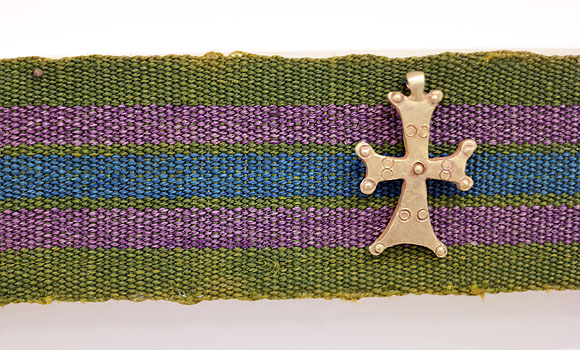
Cross by Romanian artist Ovidiu Simionescu
Second, the cross represents the standard by which you endeavor to persevere when you are being persecuted for your faith: “Let us fix our eyes on Jesus, the author and perfecter of our faith, who for the joy set before him endured the cross, . . . consider Him who endured such opposition from sinful men, so that you will not grow weary and lose heart” (Hebrews 12:2-3). Third, the cross reminds you of what God was willing to bear in order to communicate His love to you, and therefore is your example of what you should be willing to undergo for others: “No one has greater love than this, to lay down one’s life for one’s friends” (John 15:13).
A Shield
The cross is “the shield of faith, with which you can extinguish all the flaming arrows of the evil one” (Ephesians 6:16). From the very beginning of Christianity, believers were using the sign of the cross as a means of protection against evil. Crosses were commonly placed upon walls, over doorways, and above beds in Christian homes to safeguard the family. Of course, it is not the piece of wood, nor the gesture of making the sign of the cross with your hand, that has magical powers; rather it is your faith that saves you (Luke 7:50, 17:19, 18:42). The cross is a powerful reminder to depend upon God when you are being tempted. Also, having a cross doesn’t necessary mean you will be rescued from the hands of men—as the 12th century crusaders found out when they marched to battle with a portion of the true cross but still lost to Saladin’s army. Nevertheless, the cross is powerful ally against the demonic forces trying to rob you of your salvation:
“Learn how great is the power of the cross; how many good things it hath achieved, and doth still; how it is the safety of our life. . . If we are on journeys, if we are at home, wherever we are, the cross is a great good, the armor of salvation, a shield which cannot be beaten down, a weapon to oppose the devil; thou bearest the cross when thou art an enmity with him, not simply when thou sealest thyself by it, but when thou sufferest the things belonging to the cross” (St. John Chrysostom).
A Sign for Gathering
The prophet Jeremiah stated, “Thus says the LORD: Stand at the crossroads, and look, and ask for the ancient paths where the good way lies; and walk in it, and find rest for your souls” (Jeremiah 6:16). The most common architectural shape for a church building is that of a cross (cruciform). Churches have crosses on the apex of their roof, on top of their steeple, or crowning their dome. There is a cross on the wall of the sanctuary, on the altar, or hanging from the ceiling. The cross is central to the Church not because it merely symbolizes the Christian faith, but because all churches stand at the “crossroads.” The church is the meeting place where people learn about the “ancient paths where the good way lies,” are instructed how to “walk in it,” and it is where believers “find rest for [their] souls.” In other words, the church—and the cross—is where you determine the course of your life or are reminded of that to which you already made a commitment to.
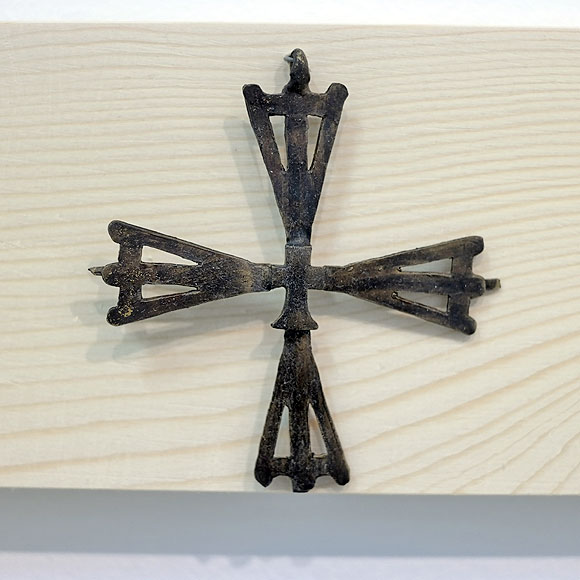
Cross by Romanian artist Ovidiu Simionescu
The Orthodox Church also believes that the cross will be the sign in the sky heralding the second advent. “On that day the root of Jesse shall stand as a signal to the people; the nations shall inquire of him, and his dwelling shall be glorious. On that day the Lord will . . . raise a signal for the nations, and will assemble the outcasts of Israel, and gather the dispersed of Judah from the four corners of the earth” (Isaiah 11:10-12). Christ said, “Then the sign of the Son of Man will appear in heaven, and then all the tribes of the earth will mourn, and the will see ‘the Son of Man coming on the clouds of heaven’ with power and great glory” (Matthew 24:30).
A Benediction
The cross is used as an expression of blessing. Throughout the Bible, people prayed using various physical gestures: uplifted hands, laying hands on another, prostrations, etc. Today, many people fold their hands when they pray although it is not a posture found in the Bible for prayer. Similarly, making the sign of the cross with one’s hand is not found in the Bible, but it has traditionally been used as a gesture to ask for God’s grace upon oneself, give a blessing to another, or to consecrate something or someone for a sacred purpose. In the third century, Tertullian, the great Christian apologist wrote:
“In every successful undertaking, at every arrival and departure, while dressing, putting on one’s shoes, in bath or at table, at lamp lighting, in bed or on seats, in a word: in all our activities, we trace the sign of the cross upon ourselves, according to the tradition of the Apostles who inspired their first disciples, and through them, all the faithful, as a sign of their confession, always to place the sign of the cross over their face and chest.”
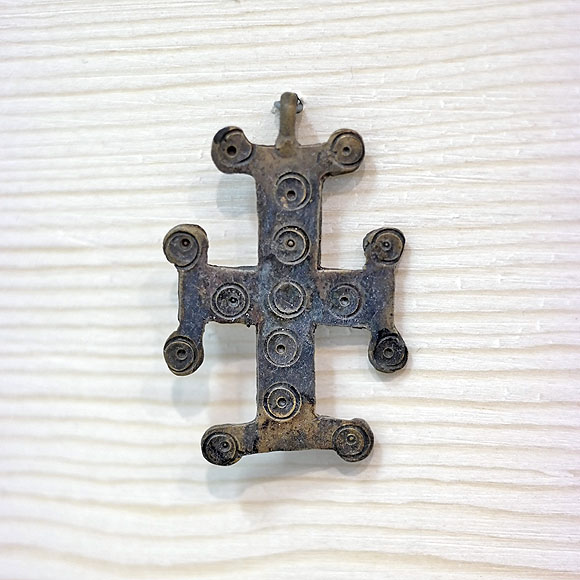
Cross by Romanian artist Ovidiu Simionescu
By the sign of the cross you are brought into the Church via Baptism. The cross is the new circumcision that identifies you as one of God’s people (Galatians 5:11, 6:14). By the cross you are sanctified to serve within the Church or to receive what the Church imparts (e.g., the Sacraments).
The Tree Of Life
The cross is symbolic of God’s promise to you of eternal life. Orthodox hymnology often connects the tree of life found in the Garden of Eden (Genesis 2:9; 3:22-24) with the cross. For example:
“O wondrous miracle! Today, the Cross is beheld raised above the earth as a Jerusalem oak teeming with life, which held the Most High. By the Cross, we have all been drawn to God, and death is swallowed up. O undefiled tree! Through you we delight in the immortal food in Eden, glorifying Christ” (The Lauds, Orthros, Sunday After the Elevation of the Precious Cross).
This fruit from the tree of life is only granted to those who overcome trials and maintain their devotion to God (Revelations 21-7). Yet it is by clinging to the cross that you are able to do both. In fact, St. Basil the Great affirms that Christians will come to metaphorically become the cross/tree of life as was described in the first Psalm:
“Thanks to the redemption wrought by the Tree of Life, that is by the passion of the Lord, all that happens to us is eternal and eternally conscious of happiness in virtue of our future likeness to that Tree of Life. For all their doings shall prosper being wrought no longer amid shift and change nor in human weakness, for corruption will be swallowed up in incorruption, weakness in endless life, the form of earthly flesh in the form of God. This tree, then, planted and yielding its fruit in its own season, shall that happy man resemble, himself being planted in the garden, that what God has planted may abide, never to be rooted up, in the garden where all things done by God shall be guided to a prosperous issue.”
A Ladder
Finally, the cross may be seen as representing the totality of the Christian message. Our Lord was suspended between heaven and earth when He was crucified, and thus reminds you, “there is one mediator between God and men, the man Christ Jesus” (1 Timothy 2:5; see also Hebrews 8:6; 9:15; 12:24). Christ symbolically becomes a type of “ladder” between this temporal world and the eternal realm beyond. St. Augustine stated, “For the Son of Man is above as our Head, being Himself the Savior, and He is below in His body, the Church. He is the Ladder, for He says, ‘I am the way.’” So looking at the cross, you should be reminded of the entire life and ministry of Jesus Christ who taught the way into God’s Kingdom. The cross may also stand for the whole history of the Church from Old Testament to present—i.e., all God has done to reach down to you as you struggle to climb up towards God (James 4:8-10). St. Jerome wrote, “The Christian Life is the true Jacob’s Ladder on which angels ascend and descend.”
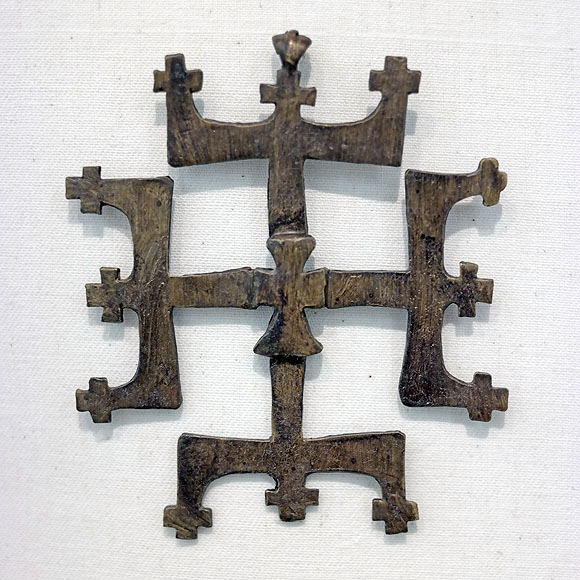
Cross by Romanian artist Ovidiu Simionescu
However, the cross not only informs you but also transforms you. Crosses are placed on graves not just to symbolize the fact the deceased was a Christian, but to also express the hope that by the cross the loved one will “cross-over” from this life to the next. There can be no resurrection without the cross. There can be no joyful entry into heaven without the cross:
“O wondrous miracle! The length and breadth of the Cross equals that of heaven, for by divine grace it sanctifies the universe. Barbarian nations are vanquished by it; scepters of kings are made firm by it. O divine ladder, by which we ascend to heaven, exalting Christ the Lord in song” (The Lauds, Orthros, Sunday after the Elevation of the Precious Cross).
Conclusion
The cross is more than a pretty piece of jewelry to wear around your neck; it is more than an attractive decoration to hang on the wall of your home; it is more than a sign that defines a particular building as being a church. Canon 73 of the Council of Trullo stated, “Since the life-giving cross has shown to us salvation, we should be careful that we render due honor to that by which we were saved from the ancient fall. Wherefore, in mind, in word, in feeling giving veneration to it.” Therefore:
“You should venerate not only the ikon of Christ, but also the similitude of His cross. For the cross is Christ’s great sign and trophy of victory over the devil and all his hostile hosts; for this reason they tremble and flee when they see the figuration of the cross. This figure, even prior to crucifixion, was greatly glorified by the prophets and wrought wonders; and when He who was hung upon it, our Lord Jesus Christ, comes again to judge the living and the dead, this His great and terrible sign will precede Him, full of power and glory. So glorify the cross now, so that you may boldly look upon it then and be glorified with it” (St. Gregory Palamas).
By Michael Bressem, Ph.D,
Originally published in Again magazine, Vol. 29, No. 1, Spring 2007. This article was posted here with the direct permission of Michael Bressem, Ph.D.


